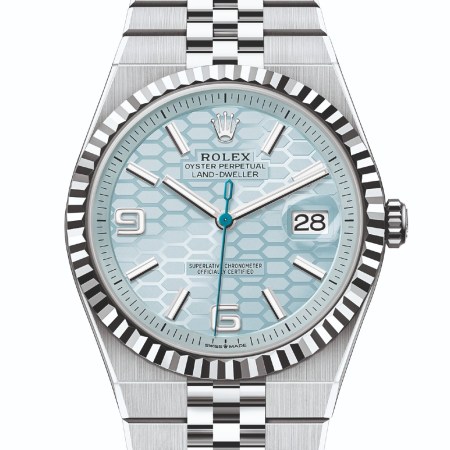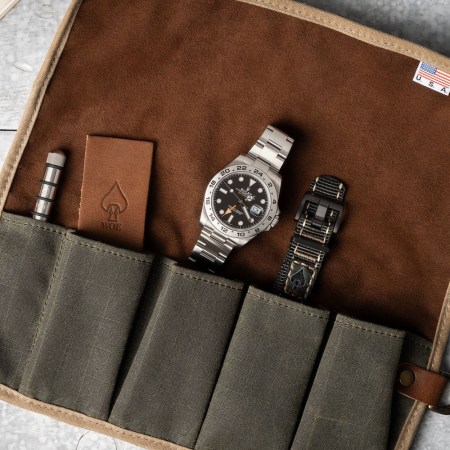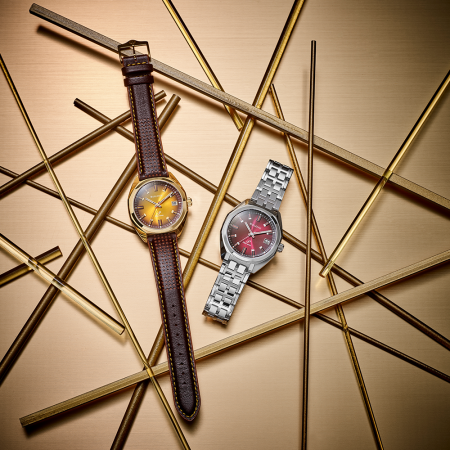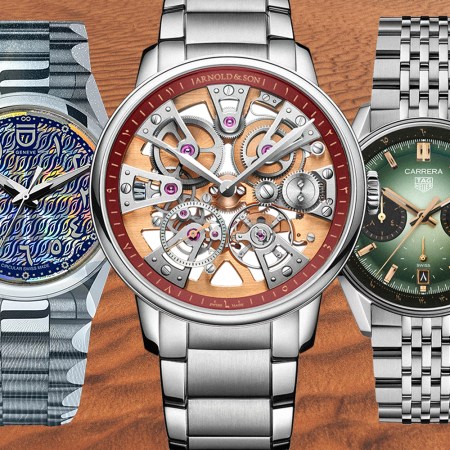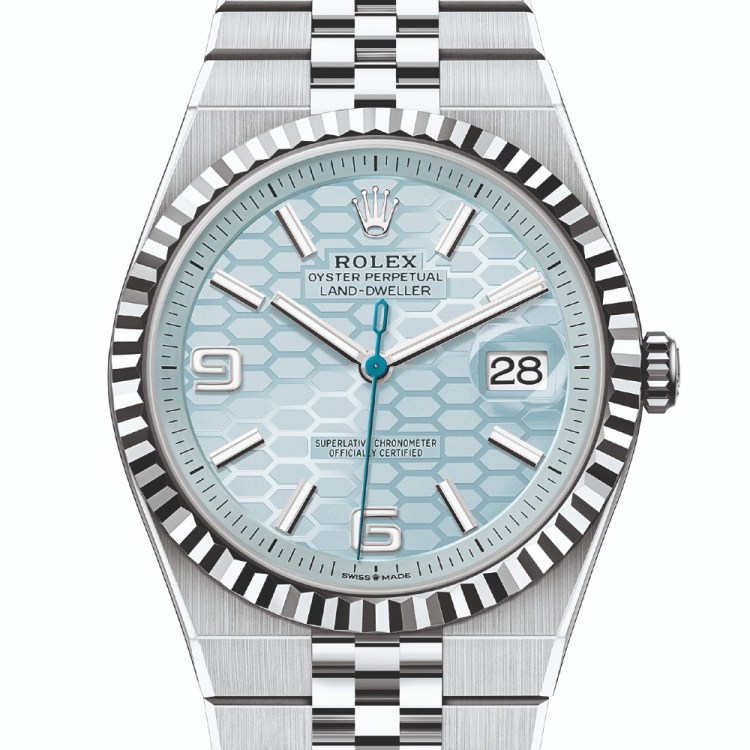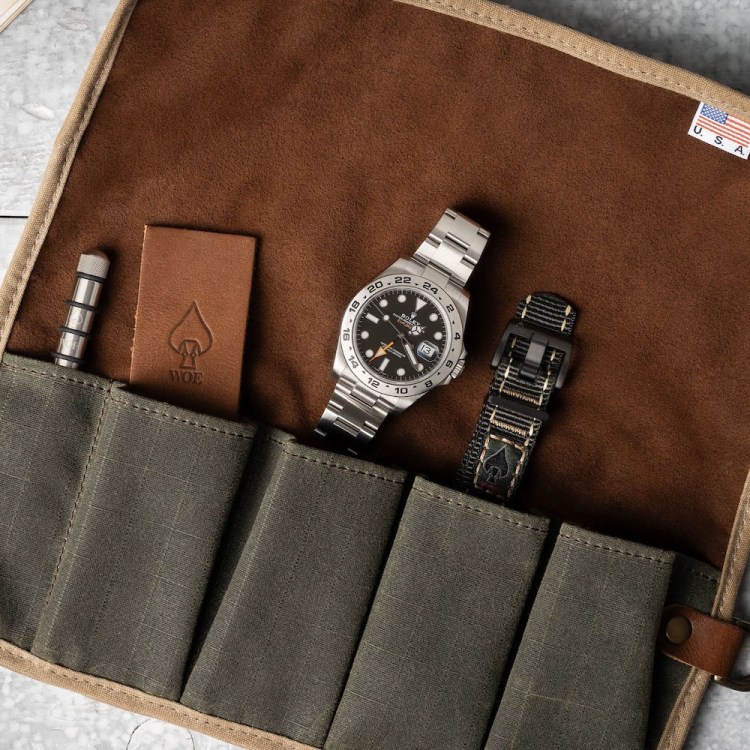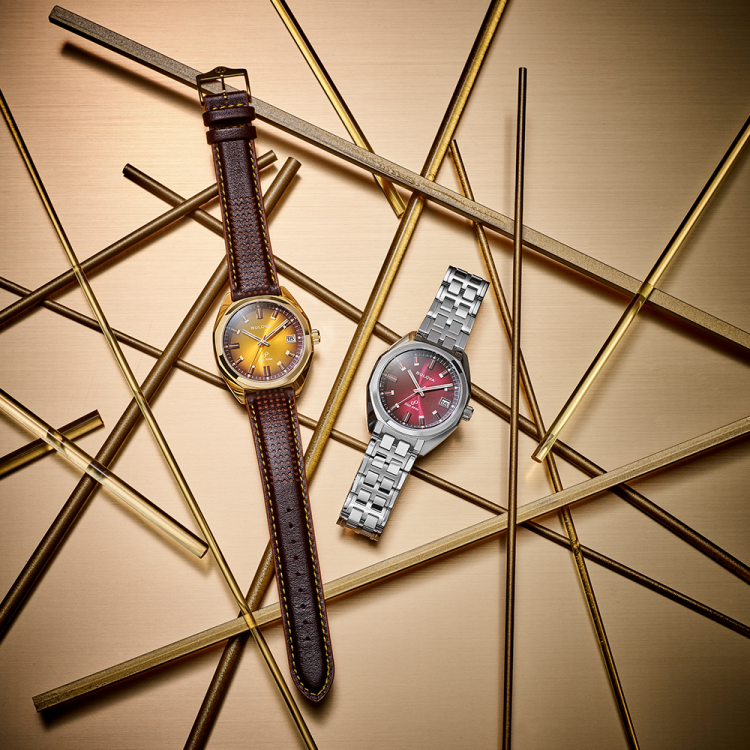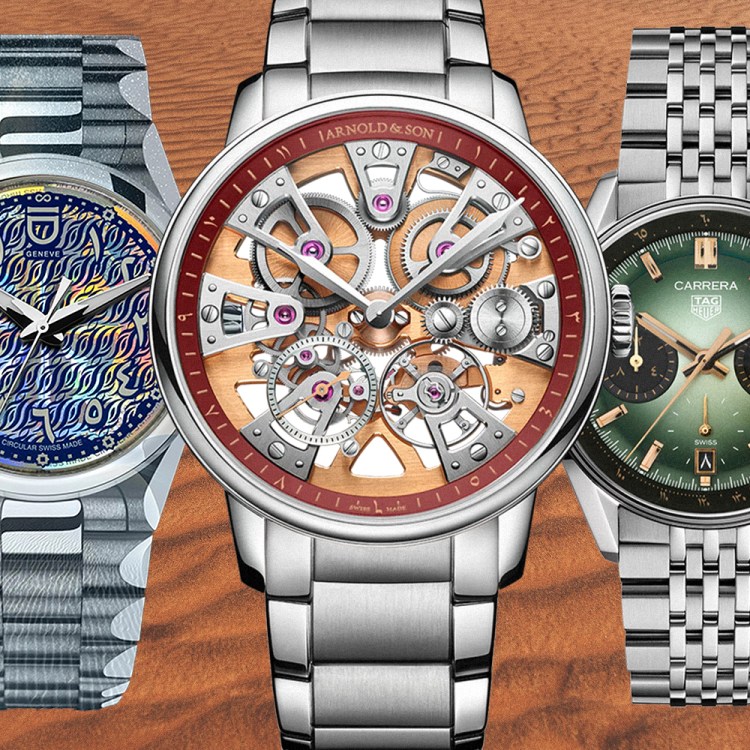In 1773, Danish horologist Jürgen Jürgensen presented his masterpiece, a repeating watch, to the Danish Watchmakers Guild in Copenhagen, Denmark. The culmination of six years of training in Germany and Switzerland, his efforts earned him the title of Master Watchmaker. Three years later, his eldest son Urban was born.
Urban’s star would eclipse even that of his talented father, sparking a multigenerational saga that continues to this day: Now, two and a half centuries following his birth, his eponymous Urban Jürgensen brand is being reborn under the ownership of an important American family and the direction of star watchmaker Kari Voutilainen, who is the recipient of a record-breaking 11 Grand Prix d’Horlogerie de Genève prizes and the most awarded independent watchmaker in the GPHG’s history. Under the auspices of co-CEOs Voutilainen and Alex Rosenfield — a veteran of the fashion and media worlds — the Danish-founded marque is bringing forth luxurious reimaginings of Urban’s original creations in wristwatch form.
Launching with three models in several different precious-metal executions, Urban Jürgensen’s new wares are executed under Voutilainen’s direction using a network of master artisans versed in hand-finishing, movement assembly and other skills. Each piece requires hundreds of hours of dedicated labor, with the brand working directly with clients to secure allocations. Limited in production, these watches represent several centuries of continuous accumulation of savoir faire, with Voutilainen himself acting as a unique thread throughout the story. (More on that in a moment.)
Much akin to the relaunch of then-dormant A. Lange & Söhne conducted by visionary watch executive Gunter Blümlein and company scion Walter Lange in 1994, the importance of this evolution is difficult to quantify. While all manner of brands went out of business or were otherwise held in intellectual-property limbo following the quartz crisis, few practiced horology at the level of Urban Jürgensen, whose founder once personally made marine chronometers for the Royal Danish Navy and heads of state. That Voutilainen, perhaps the most important independent watchmaker of his generation, would choose to direct his own efforts toward the realization of this dream is telling.

The Beginning of Urban Jürgensen
Urban, born in 1776, set out on an apprenticeship journey — much as his father had before him — at the age of 21. Having already studied horology under his father’s tutelage, he made his way to France and England, where he had the tremendous fortune of studying in the workshops of Abraham-Louis Breguet, Ferdinand Berthoud and John Arnold. Due to his Danish citizenship, Jürgensen was able to navigate the geopolitical waters that would otherwise have stifled the ambition of an Englishman or a Frenchman desiring to work with his fellows across the Channel. (The two countries were archrivals and soon to be engaged in the Napoleonic Wars.)
Returning to Copenhagen in 1801, Urban got to work designing marine chronometers, astronomical pendulum clocks, and even a bi-metallic pocket thermometer that functioned better than standard mercury-based models in freezing temperatures. His 1804 treatise Rules for the Accurate Measurement of Time by Watches and Clocks — published at the age of 28 — was the first Danish book on watchmaking and is still in use today. The influence of Breguet, Arnold and Berthoud combined with his Danish sense of design in functional, forward-thinking, beautiful timepieces began to impress in the highest circles: In quick succession, Jürgensen became the official supplier of marine chronometers to the Royal Danish Navy; the first tradesman inducted into the Royal Danish Academy of Sciences; and, in 1824, a Knight of the Order of the Dannebrog.
The Best Watches of May 2025
Limited-edition high-end wares abound, but so do sub-$1,000 field watchesUrban, who died in 1830 at the age of 53, was succeeded by sons and grandsons of substantial horological and business acumen. Between 1919 and 1976, ownership of his company passed through numerous hands — including those of Ed Heuer & Co. — before being taken over by Christian Gundesen, a local journeyman watchmaker in Copenhagen whose shop sold vintage Jürgensen clocks, watches and memorabilia. Swiss collector Peter Baumberger, passing through town in 1976 — the 200th anniversary of Urban’s birth — became enthralled with the idea of relaunching the brand. After liquidating his collection of antique clocks and watches, he used the seed money to buy equipment and partnered with star English watchmaker Derek Pratt, a contemporary of George Daniels.
Beginning with a first series of high-end pocket watches featuring teardrop lugs, stepped cases, and two-tone, frosted and hand-guilloché dials, the pair enlisted a young Finnish watchmaker named Kari Voutilainen whose handmade, tourbillon-equipped pocket watch Baumberger wished to purchase. Declining to sell the pocket watch, Voutilainen instead went to work for the newly reformed Urban Jürgensen brand, personally learning hand-finishing techniques from Pratt. During this time, Voutilainen completed assembly on the Urban Jürgensen Derek Pratt Oval Pocket Watch, which Pratt had begun in 1982 and became too ill to finish. (This watch, which includes a one-minute flying tourbillon with a constant-force mechanism as well as a moon-phase display, would later hammer at Phillips for an astounding $4.22 million in November of 2024.)
This horological triumvirate represented the second golden age in the company’s history and continued until Voutilainen left in 2002 to start his own brand. Baumberger, who became one of Voutilainen’s biggest clients, passed away in 2010, while Pratt passed away in 2009. One of the former’s close friends, noted horological historian and collector Dr. Helmut Crott, took over ownership of Urban Jürgensen in 2011, selling it to a Danish private equity consortium in 2014 that expanded its collections and opened a headquarters in Biel, Switzerland. Finally, in 2021, the Rosenfields, a family with a background in financial services, fashion and media, purchased the company, tapping Voutilainen to return as co-CEO.
In a full-circle moment, the man who remade the brand into a modern powerhouse received a second opportunity to do the same — this time with considerably more resources.

The Re-Rebirth
Duties between co-CEOs Voutilainen and Rosenfield are split between overseeing production of the watches and running the business. The idea is to marry Swiss precision with Danish design, crafting wristwatches that embody Urban’s original sensibilities while delivering unparalleled chronometric accuracy. Work is painstaking and time-consuming, resulting in limited-series watches that take, on average, more than a month to produce and are allocated to specific clients. Crafting the brand’s signature “observatory” hands, for example, is a 50-step process, while the openworked hour hands alone consist of four separate components. Cases are hand-finished with anglage, while engine-turned, hand-guilloché dials require an average of four days to machine.
Inspiration from the brand’s illustrious past abounds, but is far from heavy handed in the way it manifests in the new collection. The new Urban Jürgensen logo, for example, is inspired by calligraphy from the King’s Watch, a pocket watch masterpiece made in 1820 for Crown Prince Frederik Carl Christian, later King Frederik VII of Denmark. This calligraphy likewise informed the custom typeface and hand-drawn numerals used by Voutilainen on each of the new watches. (The typical “12” numeral, for those paying attention, has been replaced with a “0” to suggest that, in Voutilainen’s words, “Every revolution is a new beginning.”)

Those who prize horological sophistication are likewise to be well served by the new pieces: the base movement across two out of three models incorporates a double-wheel natural escapement that reduces friction while achieving optimal energy transfer. Descended from Breguet’s natural escapement technology, this movement delivers an impulse to the balance wheel via an impulse roller, which achieves 30% more efficiency than traditional Swiss lever escapements, the norm in the industry since the mid-18th century. “Elements that might equip only the most rarefied watches of other companies are standard in our three-hand watch,” says Rosenfield.
The double-wheel natural escapement is not, however, the be-all, end-all of the brand’s movement philosophy. The UJ-1, which translates the Urban Jürgensen Derek Pratt Oval Pocket Watch into wristwatch form and incorporates a tourbillon with a constant-force mechanism and deadbeat seconds, employs a different technology to achieve its aims. “Each watch will be designed with the movement technology that best fits our philosophy of excellence and our mission of pursuing perfection for the joy of doing it,” says Voutilainen.
The New Collection
The launch collection consists of three models: the UJ-1 250th anniversary watch; the UJ-2 three-hander with double-wheel natural escapement; and the UJ-3 perpetual calendar with instantaneous moon phase, also built upon the double-wheel natural escapement. Each is limited in production and serves to bridge the gap between the Baumberger-Pratt-Voutilainen era and the modern incarnation of the brand, merging historical influence with modern technology while maintaining the handmade magic that defines a Jürgensen timepiece. Common themes between each of the models are the case design, which incorporates teardrop lugs and pocket-watch influence, and the sterling silver dials, which use hand guilloché in Clous de Paris and Grain d’orge patterns to foster a sense of depth.
Furthermore, each movement features 5N gold plating and a wide range of hand-finishing: grenage, perlage, black polishing, satin finishing and more. “A UJ watch owner may never see some of the decoration and detail that is hidden deep inside the watch’s case, but they will know that time was taken to do things right and see an object that aspires to perfection in its making,” says Rosenfield. “We do this not because perfection is the key to accuracy — though it is — but because perfection is a goal of its own and a source of joy.”

UJ-1 250th Anniversary Watch
Limited to 75 pieces across three metals, the UJ-1 is a reimagining of the Urban Jürgensen Derek Pratt Oval Pocket Watch — including its movement — in wristwatch form. Available in a platinum case with a light silver dial, a platinum case with a grey dial, or a rose-gold case with a light silver dial, this piece is based around a spectacular in-house movement: 5N rose-gold plated and hand-wound, it features a one-minute flying tourbillon with a remontoir d’égalité constant-force mechanism, a flying barrel, a Swiss lever escapement and deadbeat seconds. (Rather than sweeping, the seconds hand advances once per second like that of a quartz watch.) Beating at 18,000 vph and boasting a 42-hour power reserve, it’s hand-finished in a mix of grenage, perlage, domed chamfering, mirror polishing and satin polishing.
The case, machined from either 950 platinum or 5N rose gold, measures a contemporary 39.5mm and 12.2mm tall with a polished, stepped bezel; Jürgensen-style teardrop lugs with a 20mm lug width; a satin-polished caseband; a non-screwed, fluted and signed crown; a hand-guilloché caseback with a sapphire window; a domed sapphire crystal with anti-reflective treatment; and 30m of water resistance.
Paired to this is a dial whose beauty competes with the movement for title of pièce dé résistance. Machined from solid silver with a galvanic color treatment, it features central hours and minutes; a small-seconds display at 6 o’clock; and a fractional power reserve indicator at 12 o’clock. Numerous hand-finishing techniques — hand-guilloché linear Grain d’orge on the main dial; Clous de Paris for the small-seconds dial; and satin polishing for the chapter ring — combine to spectacular effect, while flame-blued Jürgensen hands lend further 18th- and 19th-century inspiration.
With its spectacular movement, design and hand-finishing, the UJ-1 250th Anniversary Watch is a stunning launch model and reflective of the brand’s ambition. Priced at CHF 368,000 excluding VAT (about $450,000), it’s a special piece for only the most diehard collectors — though there’s little doubt that all 75 pieces will quickly find homes.

UJ-2
The UJ-2 has within its precious-metal confines a secret known only to the wearer: that the hand-wound, in-house Caliber UJ-2 movement features a double-wheel natural escapement. Completely hand-finished and beating at 18,000 vph with a 52-hour power reserve, this brilliant engine is a speciality of Voutilainen’s. Descended from natural escapement technology developed by Abraham-Louis Breguet, it achieves 30% more power efficiency than a standard Swiss lever escapement while enhancing chronometric accuracy. Perfectly impressive in its time-only form, it can also serve as a base upon which to layer other complications (see the UJ-3 below).
Available in platinum with a light silver dial; platinum with a blue dial; rose gold with a light silver dial; or rose gold with a blue dial, the UJ-2 measures 39mm and 10.9mm tall with a stepped, polished bezel; Jürgensen-style teardrop lugs with a 20mm width; a satin-polished caseband; a non-screwed, fluted, UJ-signed crown; a domed sapphire crystal with anti-reflective treatment; and a hand-guilloché caseback with circular Gain d’ogre, and a sapphire crystal; and 100m of water resistance. Similarly to the UJ-1, the UJ-2’s dial is rendered in solid silver with a galvanic color treatment — in this case, however, it features an offset central hours and minutes track; an offset small-seconds display at 5 o’clock; and a fractional power reserve display at 12 o’clock. Hand-finishing abounds as it does on the dial of the UJ-1, with the subtle contrast between the Grain d’ogre, Clous de Paris and matte finishes lending it a particularly sophisticated look.
Completed with a hand-stitched alligator leather strap with calfskin lining and a platinum or rose-gold pin buckle, the UJ-2 lists for CHF 105,000 excluding VAT (about $130,000).

UJ-3
Using the same exquisite finishing techniques and the double-wheel natural escapement from the UJ-2, the UJ-3 incorporates a perpetual calendar with instantaneous moon phase developed by master engineer and watchmaker Andreas Strehler to stunning effect. The first serially-produced model to license Strehler’s moon-phase technology, the UJ-3 is a fusion of influences — of Breguet’s movement technology, of Urban Jürgensen’s aesthetics, of Swiss performance and precision, and Voutilainen’s own Finnish sensibilities.
While the case is taller than that of the UJ-2 (13.9mm vs. 10.9mm), the two housings are otherwise similarly finished. Available in platinum with a black dial or rose gold with a black dial, the UJ-3 features a hand-wound, in-house movement with an integrated perpetual calendar mechanism finished in 5N rose-gold plating. Consisting of 484 components and 42 jewels, it boasts a free-sprung balance with a direct double-wheel escapement; an instantaneous jump mechanism at midnight; a leap-year indicator; a beat rate of 18,000 vph; and a power reserve of 52 hours. Beautifully finished in the manner of the UJ-1 and UJ-2 movements, it features a moon phase accurate to one day every 14,000 years. (Thankfully, the movement is visible via a sapphire caseback — in addition to its handsomely finished bridges and other componentry, a leap-year indicator is on display at 10 o’clock.)
The UJ-3’s dial is wonderfully balanced in the manner of the best QPs: With offset central hours and minutes; a combination date/small-seconds indicator at 5 o’clock; a moon-phase indicator at 8 o’clock; an offset day aperture at 9 o’clock; an offset month aperture at 3 o’clock; and a fractional power reserve indicator at 12 o’clock, it still leaves plenty of negative space through which to enjoy its multiple finishes, while the custom typography conveys a playful reference to the brand’s 18th-century roots.
Priced at CHF 168,000 excluding VAT (about $205,000), the UJ-3 is sure to become a modern complicated classic of the high-end independent scene.
The Bottom Line
Whether or not the relaunch of Urban Jürgensen will rank in significance alongside that of A. Lange & Söhne in 1994 will surely take some years to ascertain. That brand, reborn like a phoenix from the ashes of the Second World War thanks to a brilliant executive and a member of the original founding family, has since cast a giant shadow across the industry — indeed, its brilliant design and expert finishing are second to none. (And this from a brand whose wares are created not in Switzerland, but in Glashütte, Germany.) Unlike Lange, however, Jürgensen boasts a continuity to its story that may be distinctly advantageous; that this is Voutilainen’s second go-around with the brand also provides a measure of stability that should not be discounted.
Priced as they are — and with the greater watch industry’s pricing trends creeping ever upward — many will no doubt find the modern incarnation of Urban Jürgensen somewhat intimidating. Much like works of fine art, however, these are timepieces whose significance and beauty don’t necessitate personal ownership. There’s no doubt that Voutilainen, Rosenfield and all those who came before them to shepherd the company through a quarter-millennium have achieved a great feat. The future for the watchmaker looks bright, indeed.
This article appeared in an InsideHook newsletter. Sign up for free to get more on travel, wellness, style, drinking, and culture.




